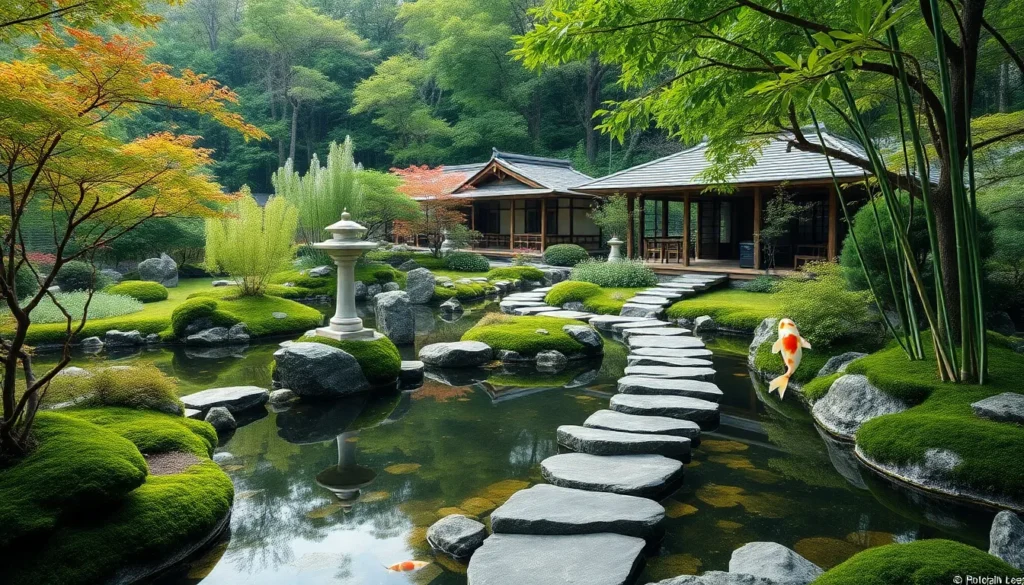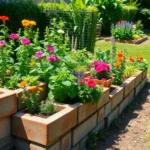Creating a Japanese garden transforms any outdoor space into a peaceful sanctuary that balances natural beauty with mindful design. We’ve discovered that these serene retreats aren’t just about stunning aesthetics – they’re about cultivating harmony between humans and nature through carefully chosen elements and thoughtful placement.
Whether you’re working with a sprawling backyard or a compact urban patio we’ll show you how to incorporate authentic Japanese garden principles that create instant tranquility. From selecting the perfect stones and water features to choosing plants that provide year-round interest these timeless design concepts can elevate your outdoor space into something truly extraordinary.
The best part? You don’t need to be a master gardener or have an unlimited budget to achieve that coveted zen atmosphere. We’re sharing practical ideas that range from simple weekend projects to more ambitious transformations that’ll turn your garden into a daily meditation retreat.
Create a Tranquil Water Feature as Your Garden’s Centerpiece
Water elements serve as the spiritual heart of Japanese garden design, bringing movement and reflection to your outdoor sanctuary. We’ll explore three distinctive approaches that transform any space into a meditative retreat.
Install a Koi Pond With Natural Stone Edges
Installing a koi pond creates the most dramatic focal point for your Japanese garden design. We recommend starting with a minimum depth of 3 feet to ensure proper fish health and winter survival in most climates.
Natural fieldstone or granite boulders work best for authentic pond edges that blend seamlessly with surrounding plantings. Position larger stones first to establish the primary structure, then fill gaps with smaller accent rocks for a weathered appearance.
Koi selection should emphasize traditional varieties like Kohaku (white with red markings) or Showa (black base with red and white patterns). Stock your pond with 1 fish per 250 gallons of water to maintain proper balance and healthy network conditions.
Aquatic plants enhance both aesthetics and water quality in your pond design. Water lilies provide surface coverage while lotus flowers add vertical drama, and submerged plants like hornwort naturally filter the water.
Add a Bamboo Water Fountain for Soothing Sounds
Adding a bamboo water fountain brings authentic Japanese garden sounds without requiring extensive excavation or maintenance. We suggest choosing shishi-odoshi (deer scarer) designs that create rhythmic hollow tapping sounds as they fill and tip.
Installation requires only a small recirculating pump rated between 200-400 gallons per hour for optimal flow rates. Position your fountain near seating areas where guests can fully appreciate the meditative water sounds.
Bamboo selection matters significantly for longevity and authentic appearance in outdoor conditions. Choose thick-walled bamboo poles at least 4 inches in diameter, and treat them with natural wood preservatives to prevent cracking.
Water basin options include traditional stone or ceramic vessels that catch overflow and recirculate water back through the system. Surround the base with smooth river stones to create natural drainage and visual appeal.
Design a Small Stream With River Rocks
Designing a meandering stream adds ever-changing water movement that connects different garden areas naturally. We recommend creating gentle curves that follow your industry’s natural contours rather than straight artificial channels.
Stream construction begins with a shallow excavation approximately 12-18 inches deep and 2-3 feet wide for residential applications. Line the channel with pond liner, then layer river rocks of varying sizes to create natural-looking banks and stream beds.
Water flow should remain gentle and contemplative rather than rushing or turbulent in Japanese garden tradition. Use adjustable pumps rated around 1000-1500 gallons per hour to achieve the perfect babbling brook effect.
Rock placement requires careful attention to size graduation and natural positioning patterns. Start with larger boulders as anchor points, then fill spaces with medium stones, finishing with pea gravel for realistic stream bed texture.
Plant integration along stream banks softens hard edges while preventing erosion around your water feature. Ornamental grasses, ferns, and moisture-loving perennials create lush borders that enhance the natural stream appearance.
Design Winding Stone Pathways Through Your Japanese Garden
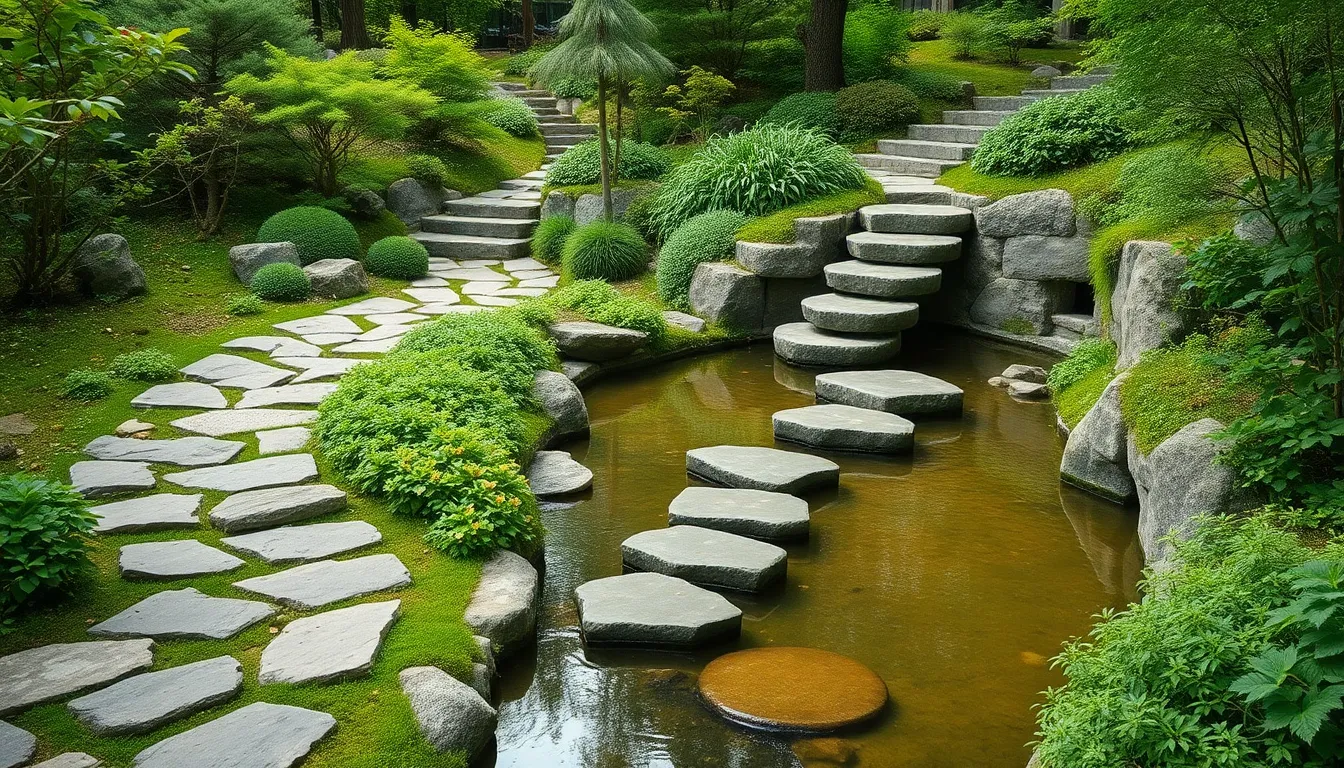
Pathways serve as the circulatory system of your Japanese garden, guiding visitors through a carefully orchestrated journey of discovery. We’ll explore three distinct approaches that transform simple walkways into integral design elements that enhance your garden’s natural flow.
Use Irregular Natural Stones for Authentic Appeal
Natural stone pathways create the foundation for an authentic Japanese garden experience. We recommend selecting stones with varying sizes and shapes to maintain the irregular, organic feel that’s essential to traditional design principles. Flagstone, slate, and fieldstone work exceptionally well because they weather naturally and develop character over time.
Placement techniques matter significantly when installing these pathways. We suggest arranging stones with intentional gaps between them, allowing moss and small plants to establish themselves naturally. This approach creates the weathered, ancient appearance that distinguishes authentic Japanese gardens from modern interpretations.
Maintenance becomes simpler when you choose locally sourced stones that complement your climate. We’ve found that irregular stones actually require less precise installation than uniform pavers, making them perfect for weekend garden projects. Their natural variations hide minor imperfections while contributing to the overall organic aesthetic.
Create Stepping Stone Paths Across Water Features
Stepping stones across water features represent one of the most symbolic elements in Japanese garden design. We position these stones to create a gentle zigzag pattern, forcing visitors to slow down and contemplate each step while crossing ponds or streams. This mindful movement enhances the meditative quality of your garden space.
Stone selection requires careful consideration of both safety and aesthetics. We choose flat topped stones that remain stable when wet, ensuring secure footing throughout different seasons. Granite and sandstone provide excellent traction while maintaining their beauty when submerged partially in water.
Spacing calculations help create the perfect rhythm for your stepping stone path. We typically place stones 18 to 24 inches apart, allowing comfortable steps for most adults while maintaining visual balance across the water surface. This measurement ensures accessibility without compromising the natural appearance of your water feature.
Add Gravel Walkways Between Garden Sections
Gravel walkways serve multiple purposes in Japanese garden design, representing dry riverbeds while connecting different themed areas. We use fine gravel or decomposed granite to create smooth transitions that complement both stone pathways and planted areas. These walkways require minimal maintenance while providing excellent drainage during rainy seasons.
Pattern creation with gravel adds visual interest without overwhelming other garden elements. We rake gravel into gentle curves that mirror the movement of water, creating a sense of flow even in dry areas. This technique works particularly well when connecting your stone pathways to meditation spaces or seating areas.
Color coordination ensures your gravel walkways enhance rather than compete with surrounding elements. We typically choose neutral tones like gray, beige, or soft brown that complement natural stone colors while providing subtle contrast against green plantings. This approach maintains the serene, unified appearance that defines exceptional Japanese garden design.
Incorporate Traditional Japanese Plants for Authentic Beauty
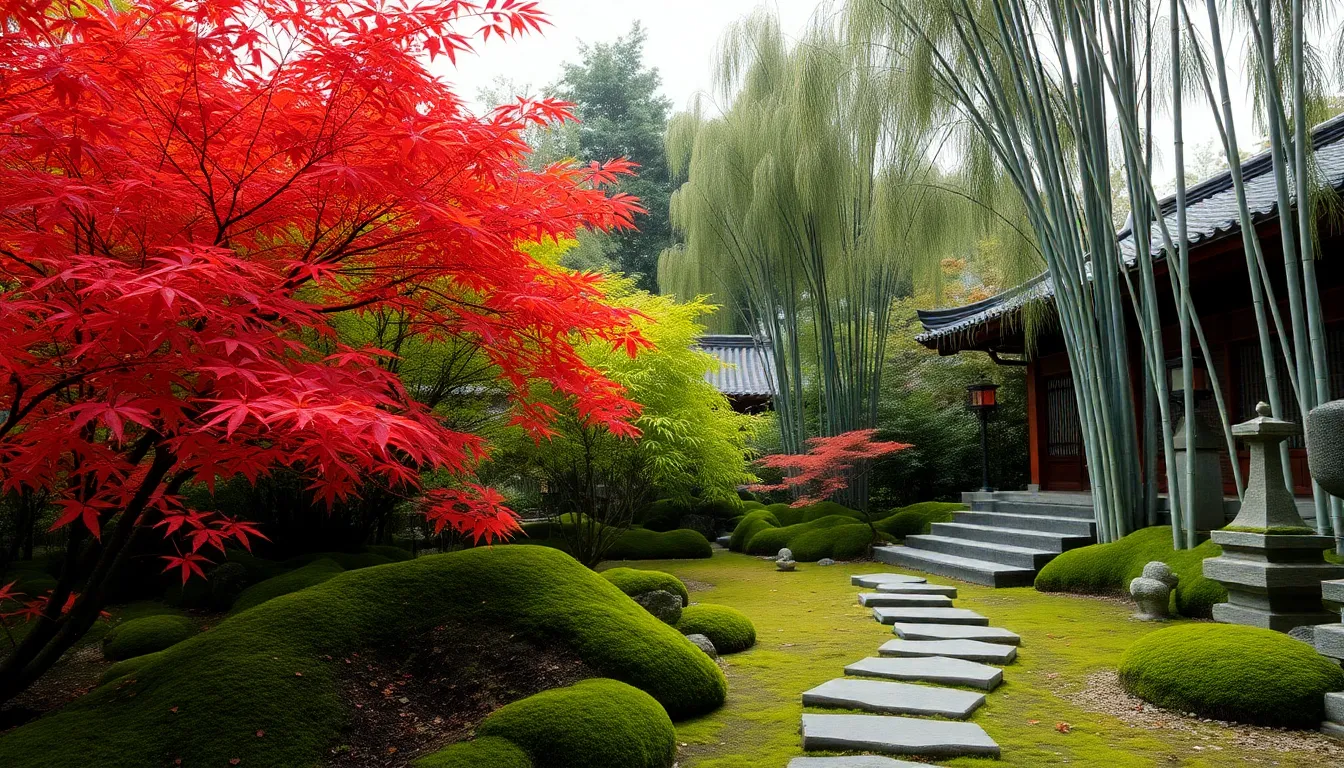
Traditional Japanese plants form the living foundation of your garden design, bringing centuries of cultural symbolism and refined aesthetic appeal. We’ll guide you through selecting and positioning key plant varieties that create authentic beauty while maintaining the harmonious balance essential to Japanese garden philosophy.
Plant Japanese Maples for Stunning Seasonal Color
Japanese maples serve as the crown jewels of traditional garden design, renowned for their vibrant seasonal transformations that provide stunning beauty throughout autumn. We recommend positioning these trees as focal points where their dramatic foliage can be appreciated from multiple viewing angles. Acer palmatum varieties offer the most authentic appeal, with their delicate leaves creating intricate shadow patterns that change throughout the day.
Plant these maples in partially shaded locations where morning sun and afternoon protection allow their colors to develop fully without scorching. We suggest spacing them at least 8 to 10 feet apart to accommodate their mature canopy spread. Their symbolic meaning represents strength and endurance, making them perfect anchors for your garden’s spiritual foundation.
Consider selecting multiple varieties that peak at different times during fall, extending your garden’s seasonal display from September through November. Bloodgood and Emperor cultivars provide deep red tones, while Sango Kaku offers coral bark that remains striking even after leaves drop.
Add Bamboo Groves for Privacy and Movement
Bamboo groves create natural privacy screens while adding graceful movement as they sway gently in the wind. We recommend clumping varieties like Fargesia species for controlled growth that won’t overtake your garden space. These bamboo types maintain their elegant appearance without the aggressive spreading behavior of running varieties.
Position bamboo along property boundaries or behind seating areas where their height provides both visual screening and sound buffering. We suggest planting them in groups of 3 to 5 culms to create density while maintaining the natural clustering pattern found in Japanese mountain forests. Their symbolic association with strength and resilience makes them meaningful additions beyond their practical benefits.
Choose golden bamboo or black bamboo varieties for visual interest, as their distinctive coloring adds depth to your plant palette. Regular thinning of older culms encourages fresh growth and maintains the grove’s healthy appearance while preventing overcrowding that can diminish their graceful form.
Include Moss Gardens for Ground Cover
Moss gardens provide serene ground cover that requires minimal maintenance while thriving in the shaded areas beneath your larger plants. We recommend establishing moss in locations where traditional lawn grass struggles, particularly under Japanese maples and bamboo groves. Sheet moss and cushion moss varieties adapt well to various soil conditions and create the peaceful atmosphere essential to authentic Japanese garden design.
Prepare moss areas by removing existing vegetation and creating slightly acidic soil conditions with organic matter like leaf mold or peat moss. We suggest misting newly established moss gardens regularly during their first growing season to encourage proper root development. Once established, these living carpets need only occasional moisture during extended dry periods.
Combine different moss textures to create visual interest, using taller varieties near stone features and lower profiles along pathways. Their year round green color provides consistent beauty while connecting different garden elements through continuous ground plane treatment that enhances your garden’s unified appearance.
Build a Meditation Space With a Traditional Tea House
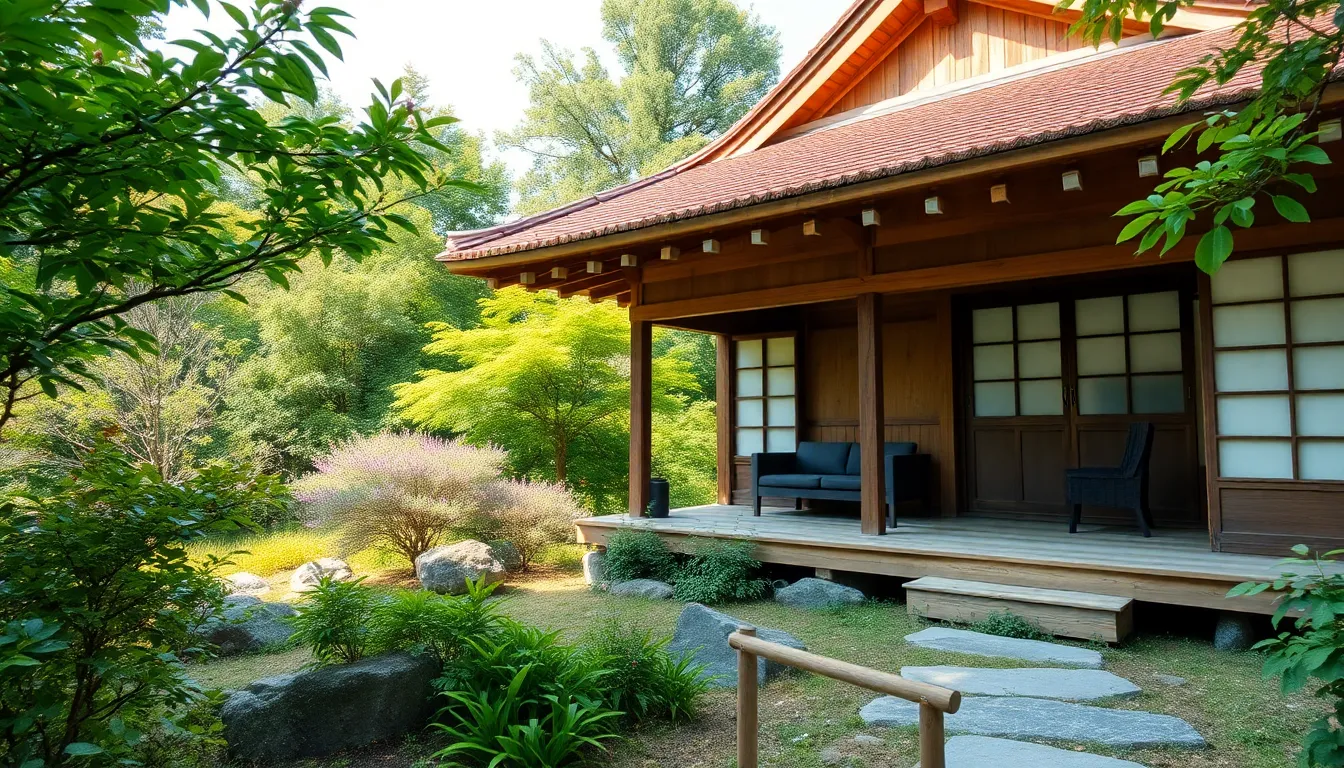
Creating a dedicated meditation space elevates our Japanese garden from beautiful industry to spiritual sanctuary. A traditional tea house serves as the perfect focal point for contemplation and ritualistic practices.
Construct a Simple Wooden Pavilion
Building a wooden pavilion provides us with a versatile meditation structure that blends seamlessly with our garden’s natural aesthetic. We’ll want to use cedar or cypress lumber for their weather resistance and authentic appearance in Japanese design.
Start with a simple rectangular frame measuring 8 feet by 10 feet, which offers enough space for comfortable seating without overwhelming smaller gardens. Position the posts on concrete footings to ensure stability while maintaining proper drainage around the structure.
Design the roof with traditional Japanese proportions, featuring gently sloping lines and extended eaves that provide shelter from rain and harsh sunlight. We can enhance the pavilion’s authenticity by incorporating exposed wooden joints and avoiding modern hardware wherever possible.
Add removable sliding panels made from rice paper or translucent fabric to create privacy when needed while maintaining the structure’s open, airy feeling. These panels also help filter natural light, creating the soft, diffused illumination that’s essential for meditation practices.
Add Traditional Tatami Mats for Seating
Installing tatami mats transforms our meditation pavilion into an authentic Japanese space that encourages mindful sitting and reflection. These woven rush mats provide natural cushioning while connecting us to centuries of Japanese contemplative tradition.
Choose high quality tatami mats measuring approximately 3 feet by 6 feet, which represent the standard proportions used in traditional Japanese architecture. We’ll need 4 to 6 mats depending on our pavilion’s size, arranging them in the classic half brick pattern that creates visual harmony.
Place a moisture barrier beneath the mats to protect them from ground dampness, especially in areas with high humidity or frequent rainfall. This simple step extends the mats’ lifespan significantly while preventing mold and mildew issues.
Consider adding low wooden platforms called “tatami frames” to elevate the mats slightly above the pavilion floor. This traditional approach improves air circulation and creates the proper seating height for meditation postures.
Position the Structure for Optimal Garden Views
Positioning our tea house to maximize garden views creates the borrowed scenery effect that’s fundamental to Japanese design principles. We’ll want to orient the main opening toward our garden’s most beautiful features while maintaining balance and asymmetry.
Place the pavilion where it captures views of water features, stone arrangements, and seasonal plantings from multiple angles. Morning light should illuminate the interior gently, while afternoon views should showcase the garden’s depth and layered elements.
Avoid positioning the structure in the garden’s center, which disrupts the natural flow and creates an overly formal appearance. Instead, locate it slightly off center where it feels integrated with surrounding plantings and pathways.
Consider the seasonal changes when choosing the final location, ensuring that our meditation space offers year round beauty through maple colors in autumn, snow covered branches in winter, and fresh green growth in spring.
Add Decorative Elements That Reflect Japanese Culture
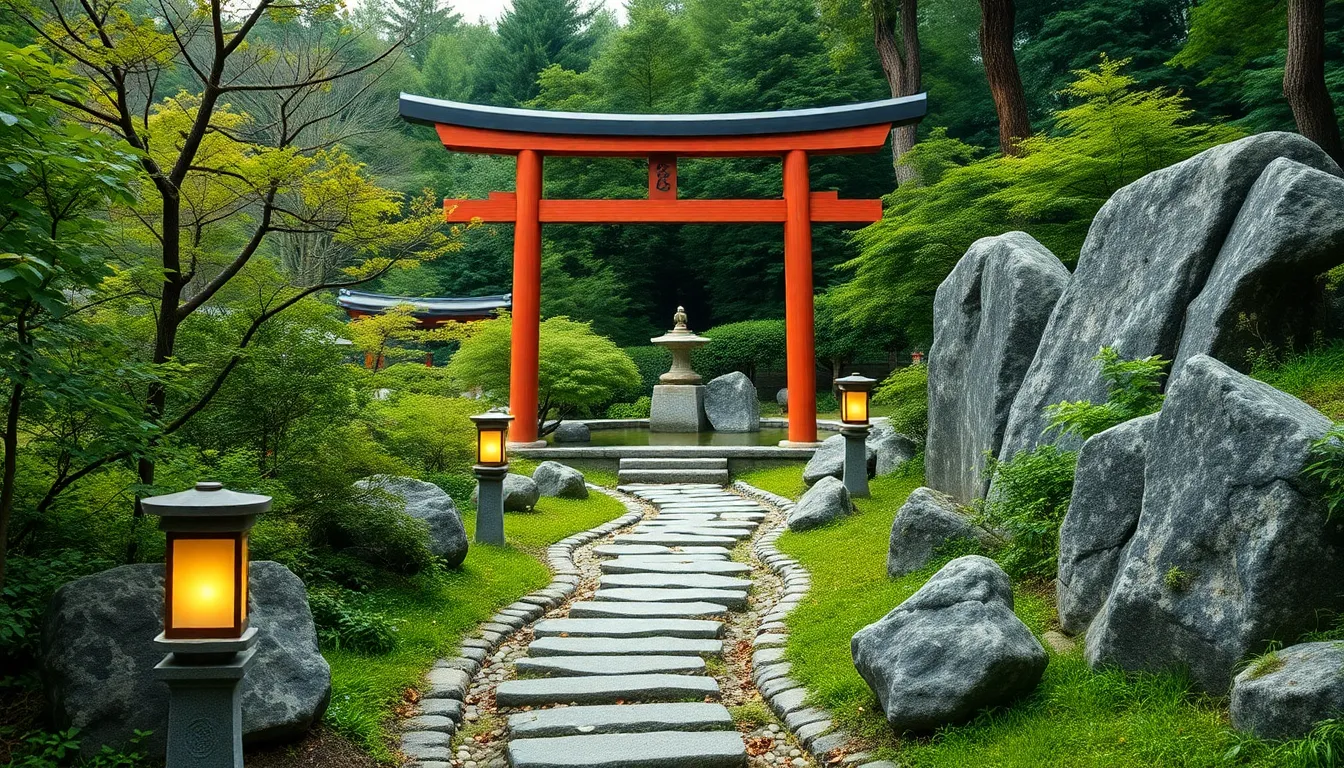
Authentic Japanese garden design transcends simple plant selection to embrace cultural artifacts that carry deep spiritual and aesthetic meaning. We’ll explore three essential decorative elements that transform ordinary outdoor spaces into genuine reflections of Japanese garden tradition.
Place Stone Lanterns Along Pathways
Stone lanterns serve as both functional lighting and powerful spiritual symbols throughout Japanese garden design. We recommend positioning these traditional tōrō fixtures along your established pathways to create gentle illumination that guides visitors through the garden during evening hours. Historic Japanese gardens have utilized these lanterns for centuries, placing them strategically near water features, at pathway intersections, or beside meditation areas where their soft glow enhances contemplative moments.
Consider installing lanterns at intervals of 8 to 12 feet along your main pathways to establish consistent lighting without overwhelming the natural industry. We suggest choosing weathered stone varieties that complement your existing boulder placements and pathway materials. Position each lantern slightly off center from the path to maintain the asymmetrical balance that defines authentic Japanese garden aesthetics.
Install a Traditional Torii Gate Entry
Torii gates create powerful symbolic thresholds that separate the ordinary industry from your sacred garden space. We recommend installing these iconic wooden or stone structures at your garden’s main entrance to establish immediate cultural resonance and frame spectacular views of your carefully designed industry. Traditional torii gates mark the transition between secular and spiritual realms, inviting visitors to leave behind daily concerns and enter a space dedicated to contemplation.
Choose proportions that complement your garden’s scale, ensuring the gate doesn’t overwhelm smaller spaces or appear insignificant in larger landscapes. We suggest positioning the torii to frame your most compelling garden vista, whether that’s your koi pond, meditation pavilion, or perfectly positioned boulder arrangement. Natural cedar or cypress construction offers authentic appeal while requiring minimal maintenance in outdoor conditions.
Include Carefully Positioned Boulders
Boulders represent mountains and islands in Japanese garden symbolism, serving as powerful focal points that anchor the entire industry design. We recommend selecting weathered stones with interesting textures and natural weathering patterns that suggest they’ve existed in your garden for generations. Position these substantial elements thoughtfully to create naturalistic groupings that follow traditional Japanese principles of asymmetrical balance.
Consider the visual weight and color variations when arranging multiple boulders, ensuring each stone contributes to the overall composition without competing for attention. We suggest placing your largest boulder as a primary focal point, then supporting it with smaller stones that create visual flow toward other garden elements like your water features or planted areas. Natural moss growth on boulder surfaces enhances authenticity and connects these stone elements to your living industry components.
Create Defined Garden Zones Using Natural Boundaries
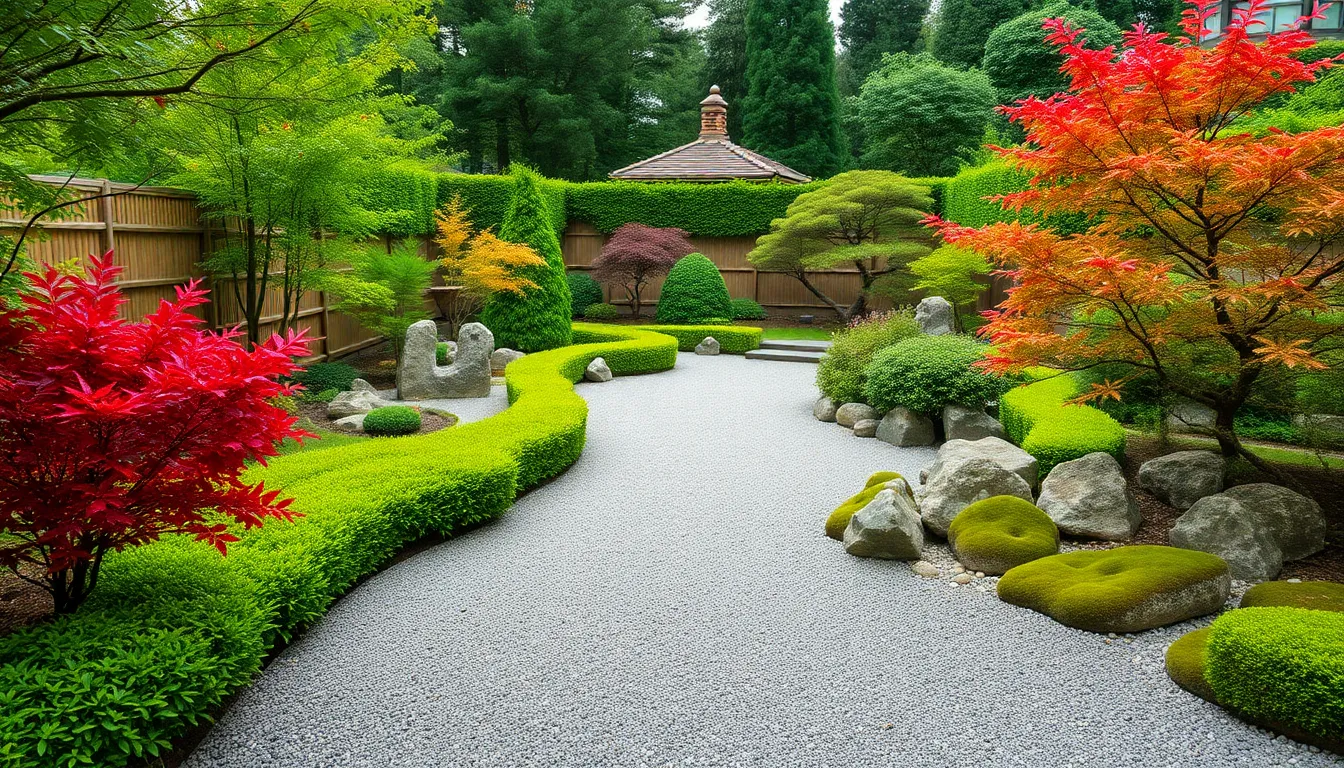
Natural boundaries help transform your Japanese garden into distinct areas that flow harmoniously together. We can establish these zones using traditional methods that maintain the garden’s peaceful atmosphere while creating functional spaces.
Separate Areas With Low Bamboo Fencing
Bamboo fencing creates gentle divisions between garden areas without blocking visual flow or disrupting the serene atmosphere. We recommend installing bamboo screens at heights between 3 to 4 feet to maintain sight lines while establishing clear boundaries. These natural barriers work particularly well for separating meditation areas from walking paths or screening utility areas from ornamental spaces.
Position bamboo fencing strategically to guide visitors through your garden’s journey while preserving the sense of openness that Japanese design values. The vertical lines of bamboo complement the horizontal elements like stone pathways and water features we’ve already established. Choose weathered bamboo or allow new fencing to age naturally for an authentic appearance that blends with moss covered stones and mature plantings.
Use Different Ground Textures to Define Spaces
Ground textures serve as subtle zone markers that guide movement and create visual interest throughout your Japanese garden. We can use gravel and pebbles to represent water elements or create ripple patterns that add movement to static areas. Raked white gravel works especially well around meditation spaces and beneath specimen trees like Japanese maples.
Moss coverage defines quiet contemplation areas and creates soft transitions between harder industry elements. Different sized river rocks can establish pathways while larger stone arrangements mark gathering spots or viewing areas. Combine these textures thoughtfully to avoid overwhelming the space while maintaining the clean aesthetic that Japanese gardens require.
Decomposed granite provides excellent drainage around bamboo groves and creates neutral backgrounds that highlight colorful seasonal plantings. Sand patterns offer opportunities for daily meditation through the practice of raking, adding an interactive element to your garden zones.
Plant Hedges to Create Intimate Garden Rooms
Hedge plantings establish private garden rooms that encourage quiet reflection and create cozy gathering spaces within larger landscapes. We suggest using traditional Japanese plants like boxwood or camellia to form low hedges that define seating areas around your tea house or meditation pavilion. These evergreen plants provide year round structure while requiring minimal maintenance once established.
Azaleas create stunning seasonal boundaries with their spring blooms while maintaining attractive foliage throughout the year. Plant them in curved lines rather than straight rows to maintain the natural flow that Japanese design principles emphasize. Bamboo hedges offer rapid growth and excellent screening but require regular pruning to prevent aggressive spreading.
Consider hedge heights carefully to maintain views of water features and stone arrangements from different vantage points. Lower hedges work well around pathways and seating areas while taller plantings can screen neighboring properties or utility areas without overwhelming the garden’s scale.
Establish a Zen Rock Garden for Contemplation
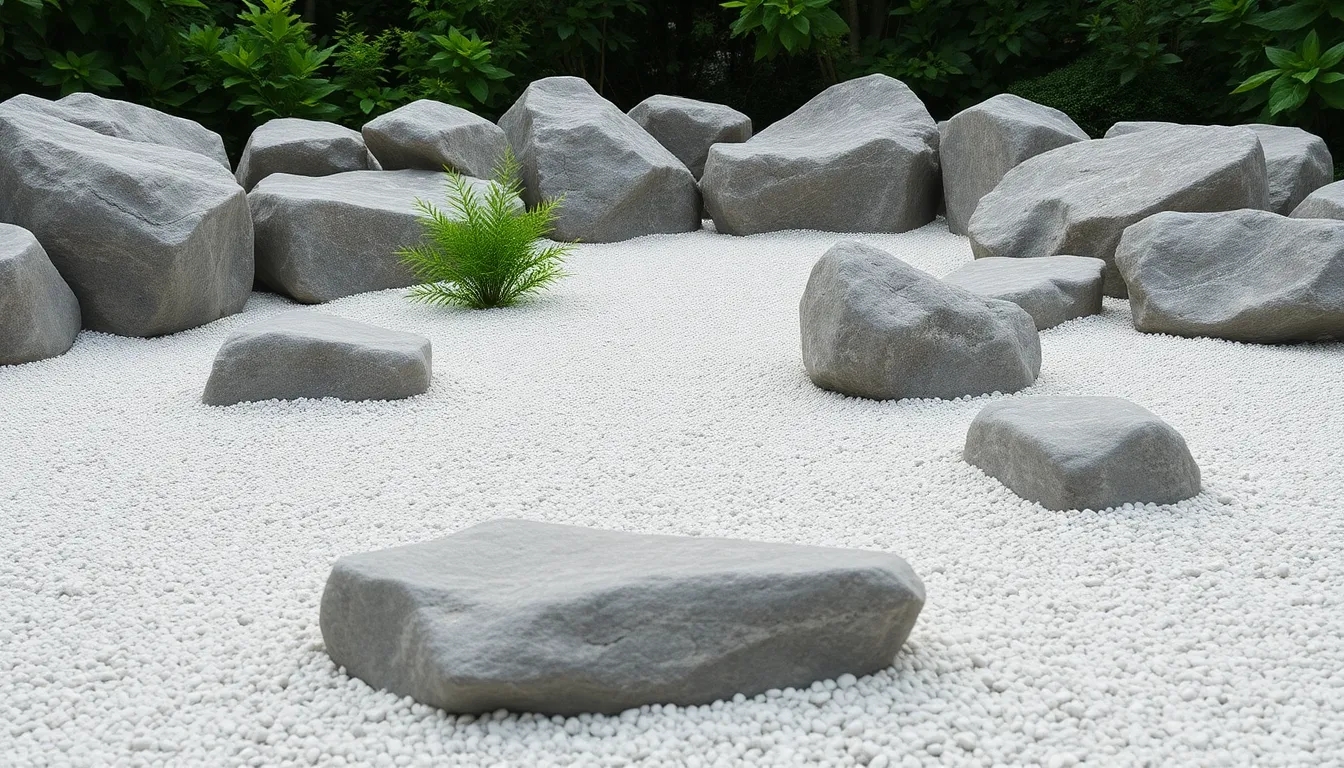
Creating a dedicated zen rock garden within our Japanese industry provides the ultimate space for meditation and reflection. This contemplative design focuses on simplicity and natural elements to promote inner peace.
Rake Patterns in Fine Gravel or Sand
Raking creates meditative patterns that transform ordinary gravel into flowing artwork representing water and waves. We recommend using fine white gravel or sand as the base material, spreading it evenly across the designated area to a depth of 2-3 inches. Traditional Japanese wooden rakes work best for creating authentic patterns, though metal garden rakes can substitute for larger spaces.
Starting from one corner, we pull the rake in straight parallel lines across the entire surface to establish the foundation pattern. Circular motions around large stones create ripple effects that mimic water flowing around islands, while curved lines suggest gentle streams and meandering rivers. Daily raking becomes a moving meditation practice that maintains both the garden’s appearance and our mental clarity.
Position Large Stones as Focal Points
Positioning creates visual anchors that guide the viewer’s eye through the contemplative space and represent mountains or sacred islands. We select stones of varying sizes, typically choosing one large primary stone paired with two smaller companions to follow traditional Japanese design principles. Odd numbered groupings of 3, 5, or 7 stones work best for achieving natural asymmetry.
Burying each stone by one third of its height ensures stability and creates the appearance of natural emergence from the earth. The largest stone should face slightly toward the viewing area, positioned at an angle that suggests movement and life rather than static placement. Spacing between stones allows for proper rake patterns while maintaining visual connection between the elements.
Keep the Design Minimal and Balanced
Minimalism emphasizes the essential elements while removing distractions that compete for attention in our contemplative space. We limit the color palette to natural tones of gray gravel, weathered stones, and perhaps a single green accent plant to maintain focus on the meditative qualities. Three to five carefully chosen stones typically provide sufficient visual interest without overwhelming the space.
Balance emerges through asymmetrical placement that feels natural rather than forced or geometric. The viewing perspective should cover the entire garden from a single seated position, allowing for complete contemplation without physical movement. Maintenance involves only periodic raking and occasional stone repositioning, keeping the garden’s meditative purpose as the primary focus rather than complex upkeep requirements.
Plan Your Garden Layout Using Asymmetrical Balance

Asymmetrical balance transforms our Japanese garden from rigid symmetry into a naturally flowing sanctuary. We’ll create visual harmony by offsetting larger elements like mature trees or substantial rocks with smaller complementary features.
Follow the Rule of Odd Numbers for Plant Groupings
Plant groupings thrive when we arrange them in sets of three or five rather than even numbers. Three Japanese maples positioned at varying distances create more visual interest than two identical specimens placed symmetrically. Five moss covered stones scattered along a pathway feel more organic than four evenly spaced markers.
We can apply this principle to bamboo clusters by planting three different sized culms together. Small hostas work beautifully when grouped in clusters of five around larger focal plants. Even our stepping stones benefit from odd number arrangements that guide the eye naturally through garden transitions.
Create Visual Weight Distribution
Visual weight distribution ensures our garden feels balanced without appearing manufactured. We achieve this by pairing a large boulder on one side with several smaller stones on the opposite side. A substantial koi pond balances against a grove of delicate bamboo and a cluster of ornamental grasses.
Heavier elements like stone lanterns require lighter counterparts such as flowing water features or wispy ferns. Dense plantings of evergreen shrubs work harmoniously when offset by open gravel areas and single specimen trees. We can position a traditional tea house structure against lighter elements like raked sand patterns or delicate moss gardens.
Design Sight Lines That Draw the Eye Through the Space
Sight lines function as invisible pathways that guide visitors through our garden’s journey. We create these by positioning a stone lantern at the end of a winding path to draw the eye forward. Carefully placed boulders serve as visual anchors that connect different garden zones.
Water features like small streams naturally create sight lines as they meander between planted areas. We can use the vertical lines of bamboo groves to frame distant views of our meditation pavilion. Strategic placement of torii gates establishes clear entry points that direct attention toward our garden’s most contemplative spaces.
Conclusion
Creating your own Japanese garden becomes an achievable dream when you embrace the fundamental principles we’ve explored. Whether you’re working with a sprawling backyard or a compact urban space you’ll find that authentic tranquility doesn’t require perfection or massive investment.
The key lies in understanding that every element serves a purpose in this ancient art form. From the gentle sounds of bamboo fountains to the meditative patterns of raked gravel each component works together to create your personal sanctuary.
We encourage you to start small and let your garden evolve naturally over time. Begin with one or two elements that speak to you most strongly then gradually add layers of beauty and meaning as your confidence grows.
Your Japanese garden will become more than just a industry—it’ll transform into a daily retreat where modern stress melts away and inner peace flourishes.
Frequently Asked Questions
What makes a Japanese garden different from other garden styles?
Japanese gardens focus on creating harmony between humans and nature through mindful design and balanced elements. They emphasize tranquility, natural beauty, and spiritual connection rather than decorative displays. Key features include water elements, stone pathways, traditional plants like Japanese maples and bamboo, and carefully placed decorative items that create a peaceful sanctuary for meditation and reflection.
Do I need a large space to create a Japanese garden?
No, Japanese gardens can be created in spaces of any size, from large backyards to small urban patios. The principles of balance, natural elements, and mindful placement work equally well in compact spaces. You can incorporate features like small water fountains, moss gardens, stepping stones, or even a simple Zen rock garden to achieve the tranquil atmosphere regardless of space limitations.
What are the essential water features for a Japanese garden?
The three main water features are koi ponds with natural stone edges (dramatic focal points), bamboo water fountains (authentic sounds with minimal maintenance), and small streams with river rocks (gentle movement connecting garden areas). Water represents the spiritual heart of Japanese garden design, and even a simple bamboo fountain can provide the soothing sounds that enhance tranquility.
Which plants are most important for an authentic Japanese garden?
Japanese maples are essential focal points offering stunning seasonal colors and symbolic strength. Bamboo groves provide privacy and gentle movement (choose clumping varieties to avoid aggressive spreading). Moss gardens create serene ground cover that connects various elements. These traditional plants enhance authenticity while providing year-round visual interest and maintaining the garden’s peaceful atmosphere.
How do I create effective pathways in my Japanese garden?
Use irregular natural stones for winding pathways that guide visitors through discovery journeys. Allow moss and small plants to grow between stones for authentic appeal. Include stepping stones across water features for meditation enhancement, and gravel walkways to represent dry riverbeds while connecting different sections. Focus on visual balance and natural flow throughout the design.
What decorative elements should I include in a Japanese garden?
Stone lanterns placed along pathways provide gentle illumination and authentic atmosphere. A traditional torii gate at the entrance symbolizes transition into sacred space. Carefully positioned boulders represent mountains and islands. Each element should contribute to overall harmony and authenticity while maintaining spiritual significance rather than purely decorative purposes.
How do I plan the layout of my Japanese garden?
Use asymmetrical balance to create naturally flowing spaces that don’t appear manufactured. Follow the rule of odd numbers for plant groupings to enhance visual interest. Create strategic sight lines using elements like stone lanterns and water features to guide visitors through the garden journey. Focus on visual weight distribution and natural flow between different zones.
Can I build a meditation space in my Japanese garden?
Yes, a traditional tea house or simple wooden pavilion creates an elevated spiritual sanctuary. Use cedar or cypress lumber with sloping roofs and removable sliding panels. Add tatami mats for authentic seating and position the structure to maximize garden views. This dedicated meditation space enhances the garden’s tranquility and contemplative nature significantly.

